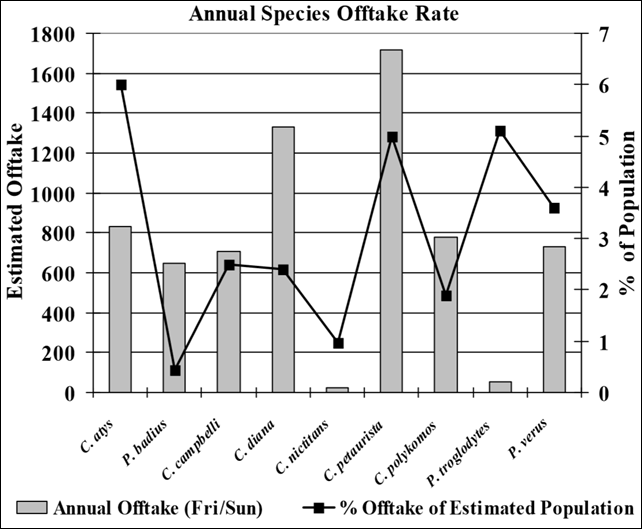Graph of the Day: Annual species offtake rate for one bushmeat market in West Africa
Estimated annual offtake rates for Friday/Sunday bushmeat market days at the Daobly market in the Ivorian town of Taï along the Cavally River. The annual offtake was calculated by doubling the average of the observed Friday offtake, and doubling again to account for the similar volume of primates traded at Sunday markets. This value was multiplied by 52 to provide an estimated annual offtake for the bi-weekly market. Population percentages were based on estimates derived from population data at Taï National Park in Ivory Coast and Sierra Leone’s Tiwai Island. Graph: Covey and McGraw, 2014 ABSTRACT: According to the IUCN [1], four of the nine anthropoid species found in Liberia are classified as either Vulnerable or Endangered and this number is likely to rise in coming years due to an increase in bushmeat hunting and a growing human population. Bushmeat hunting is the primary cause of primate loss in West Africa and current estimated offtake rates combined with habitat loss have placed four taxa endemic to Upper Guinea forests in danger of extirpation. We surveyed one bushmeat market located on the Liberia – Ivory Coast border to assess the general impact of hunting in one area of Liberia. This market, located near the Ivorian town of Taї, receives meat daily from the Konobo District of eastern Liberia. We visited the market eight times over a four month period in 2009/2010, during which we counted 723 animals including 264 primates. According to our surveys of the market, Cercopithecus petaurista (Lesser spot-nosed monkey) [25% of all primates] was the most abundant primate, followed by Cercopithecus diana (Diana monkey) [19.3%], Cercocebus atys (Sooty mangabey) [12.1%], Colobus polykomos (King colobus) [11.4%], Procolobus verus (Olive colobus) [10.6%], Cercopithecus campbelli(Campbelli monkey) [10.2%], and Procolobus badius (Western red colobus) [9.5%]. We estimate an average of thirty-three primates were exchanged each day we visited and that a minimum of 9,500 primates are traded annually at this locale (6,900 during formal market days and 2,600 on non-market days). Based on an estimated offtake rate of 2.76%, our preliminary analysis suggests that primates in Liberia’s Konobo District are likely being hunted at rates approaching unsustainable levels and are in danger of extirpation.
